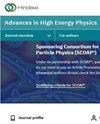电子-介子对撞机的物理案例
IF 1.5
4区 物理与天体物理
Q3 PHYSICS, PARTICLES & FIELDS
引用次数: 20
摘要
提出了一种以多ab-1集成光度为目标的具有不对称碰撞轮廓的电子μ介子对撞机。这种新型对撞机在20–200的碰撞能量下运行 GeV,50–1000 GeV和100–3000 GeV将能够探测带电的轻子风味破坏并精确测量希格斯玻色子的性质。与电子-电子或μ介子-μ介子对撞机相比,电子和μ介子束的碰撞导致更少的物理背景,因为电子-μ介子相互作用主要通过高阶矢量玻色子聚变和矢量玻色子散射过程进行。不对称碰撞轮廓导致碰撞产物向电子束侧增强,这可以在很大程度上减少μ介子束的束诱导背景。考虑到这一点,人们可以想象一个轻子对撞机复合体,从10次碰撞开始 历史上第一次使用GeV电子和μ介子束,探测带电轻子风味破坏,然后升级为50-100的对撞机 GeV电子和1-3 TeVμ介子束测量希格斯粒子的性质并寻找新的物理,最终被转换为TeV规模的μ介子对撞机。成本应该从1亿美元到几十亿美元不等,对应于不同的阶段,这使得资金情况更加实际。本文章由计算机程序翻译,如有差异,请以英文原文为准。
The Physics Case for an Electron-Muon Collider
An electron-muon collider with an asymmetric collision profile targeting multi-ab-1 integrated luminosity is proposed. This novel collider, operating at collision energies of, e.g., 20–200 GeV, 50–1000 GeV, and 100–3000 GeV, would be able to probe charged lepton flavor violation and measure Higgs boson properties precisely. The collision of an electron and muon beam leads to less physics background compared with either an electron-electron or a muon-muon collider, since electron-muon interactions proceed mostly through higher-order vector boson fusion and vector boson scattering processes. The asymmetric collision profile results in collision products that are boosted towards the electron beam side, which can be exploited to reduce beam-induced background from the muon beam to a large extent. With this in mind, one can imagine a lepton collider complex, starting from colliding order 10 GeV electron and muon beams for the first time in history and to probe charged lepton flavor violation, then to be upgraded to a collider with 50-100 GeV electron and 1-3 TeV muon beams to measure Higgs properties and search for new physics and finally to be transformed to a TeV-scale muon-muon collider. The cost should vary from order 100 million to a few billion dollars, corresponding to different stages, which make the funding situation more practical.
求助全文
通过发布文献求助,成功后即可免费获取论文全文。
去求助
来源期刊

Advances in High Energy Physics
PHYSICS, PARTICLES & FIELDS-
CiteScore
3.40
自引率
5.90%
发文量
55
审稿时长
6-12 weeks
期刊介绍:
Advances in High Energy Physics publishes the results of theoretical and experimental research on the nature of, and interaction between, energy and matter. Considering both original research and focussed review articles, the journal welcomes submissions from small research groups and large consortia alike.
 求助内容:
求助内容: 应助结果提醒方式:
应助结果提醒方式:


